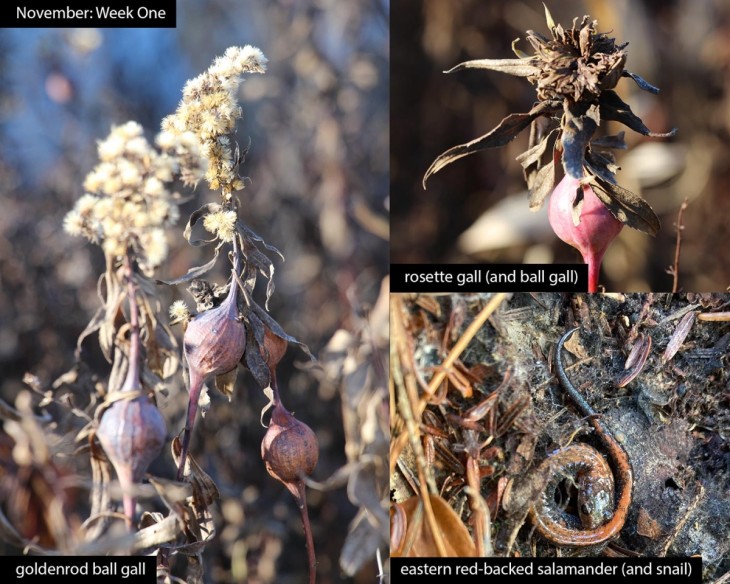This week in the woods, the landscape shows its skeleton, and we can see the true ridgeline beneath the now-leafless hardwoods. Also more apparent during the beginning of this bare month are goldenrod ball galls, which formed in summer when lone larvae of the goldenrod gall fly (Eurosta solidaginis) bored into the plants’ stems. These woody globes serve as cold-weather homes to the insects through hibernation but offer little insulation; instead, the larvae rely on a slowed metabolism and the synthesized alcohol glycerol to lower their freezing point. Glycerol, also produced by various other insects and amphibians and used in some commercial antifreezes, prevents ice crystals from forming inside cells. Goldenrod gall flies can survive temperatures as low as -58 degrees. Read more about these insects’ lifecycles in this Outside Story piece by Declan McCabe from the archives.
One host to a gall ball we saw also shows the remnants of a rosette gall, the result of yet another insect laying its eggs in the plant and chemically hindering its growth. The goldenrod gall midge (Rhopalomyia solidaginis) stunts the leading bud and causes leaves to grow into a rosette around the stem. The rosette shelters the hatchling as it matures (as well as other insects and arachnids). Unlike Eurosta solidaginis, Rhopalomyia solidaginis does not overwinter in its aboveground gall; instead, adult midges that emerge from the rosette in September and October mate within two weeks, lay their eggs in the soil, and die. Once hatched, the resulting fall generation of larvae burrow into goldenrod rhizomes, where they stay until spring pupation.
Also underground but still very much active, even this late in the fall, is the eastern red-backed salamander. Unlike animals that produce glycerol and other chemicals resistant to freezes, these salamanders must avoid the cold using behavioral mechanisms alone. As Mary Holland notes on her Naturally Curious blog, they remain terrestrial year-round and don’t hibernate until temperatures remain steadily in the 30s and 40s, sending the salamanders burrowing below the frost line.
What have you noticed in the woods this week? Submit a recent photo for possible inclusion in our monthly online Reader Photo Gallery.


